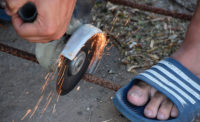Too often frontline supervisors see their job as primarily ensuring compliance with safety rules and regulations. But compliance only goes so far. To create the safest possible work environment, organizations need more than just compliance. They need workers to do the right thing all the time, even when supervisors aren’t watching. They need engaged employees—employees who are willing to get involved, identify and report hazards, provide peer-to-peer feedback on safe or at-risk behavior, and admit when near misses or mistakes have occurred.
All of these things are discretionary—that is, they are not requirements of the job, but they make all the difference in creating the optimal safety environment. Here is the catch—you can’t get engagement with a compliance focus.
So how can frontline supervisors go beyond compliance and create an environment where the workforce is truly engaged in safety? Here are five supervisory practices:
1 Build relationships
It’s no coincidence that supervisors who have strong relationships with their crews tend to have safer crews. So how are relationships built? The first step is to treat direct reports like people, not just employees. Supervisors must demonstrate they truly care about their direct reports, and in particular about their health and safety.
The second step is to ask more and tell less. Supervisors too often believe that because they are the “boss” they are supposed to have all the answers. By asking more than telling, leaders learn more about direct reports, leave them feeling valued and respected, and end up with more optimal safety solutions.
A third key -- build trust. Do what you say you will do. The formula is simple, following through with it is not.
2 Make hazard remediation a priority
It’s impossible to have the safest possible work environment if hazards don’t get reported and removed. Hazard remediation relies on frontline employees to identify and report hazards, and on management to fix them.
The frontline supervisor is often the point person—the person the hazards get reported to. A critical role of frontline supervisors is to shepherd hazards through whatever organizational systems are in place to remediate them. It isn’t always the role of the frontline supervisor to do this, but it behooves them to make it their responsibility. Why? Frontline employees gauge how truly important safety is in an organization by management’s willingness to invest in keeping the workplace as free of hazards as possible. Since frontline supervisors are the face of management (and often the person the hazard was reported to) it’s essential they be proactive around hazard remediation.
3 Provide feedback on behaviors that matter
Frontline supervisors have opportunities every day to observe safe and at-risk behavior and provide feedback for improvement. Too often the focus is on less critical behaviors. Unless they deliberately plan otherwise, supervisors are likely to provide feedback on what they happen to see when in a work area; most often PPE, housekeeping and other easy-to-observe safety behaviors. Since supervisors have limited time and opportunity to give feedback, it’s important to ask if those are the behaviors that will protect the workforce from the most frequent injuries and the most catastrophic. For deliberate and effective feedback, use data to target behaviors that prevent both high frequency incidents (e.g., slips trips and falls) and less likely catastrophic events (e.g., explosions, chemical releases).
4 Use more positive reinforcement
When supervisors change their focus to what people are doing well and purposely recognize the safe behaviors they want more of, they strengthen those safe behaviors, make them more consistent, and at the same time build relationships, trust, morale and engagement. This isn’t easy. It requires fighting the temptation to manage only exceptions (the default approach for most supervisors), which leads to the use of more negative consequences. Here are some tips for making reinforcement most effective:
• Be Specific. Vague statements like “good job” don’t lead to behavior improvement. Pinpointing the specific safe behaviors observed ensures those behaviors get strengthened.
• Be Sincere. Everyone can see through disingenuous attempts at reinforcement, so sincerity is essential.
• Individualize it. Reinforcement is not a one-size-fits-all proposition. Learn what works best for each of your direct reports.
• Deliver Immediately. The more immediate reinforcement is the more effective it is. Catch people in the act and reinforce.
5 Respond carefully to failure
An essential ingredient to improve safety is to know where problems and organizational weaknesses exist. This requires frontline employees reporting minor incidents and near misses. Undesirable safety events provide insight into how safety is really working, as opposed to how we think it is working. They uncover weaknesses in safety systems and processes that, in turn, enable changes to be made to prevent future incidents.
But most supervisors (and managers) inadvertently discourage reporting of minor incidents and near misses by how they react. Signs of frustration, disbelief or anger are only the start. Reporting often leads to unpleasant paperwork, investigations that feel like inquisitions, and sometimes discipline for those who report. While these situations can be complicated, supervisory reaction to the reporting of such events should be some form of “thanks for telling me, let’s figure out how to prevent this from happening again.”
To be clear, this isn’t about positive reinforcement for incidents, near misses or unsafe actions; it is positive reinforcement for the honest reporting of those events.
While there is more to effective frontline safety supervision, these tips can help build engagement, which makes the job of frontline supervision much easier. There is no job more difficult, nor one more important to safety.



